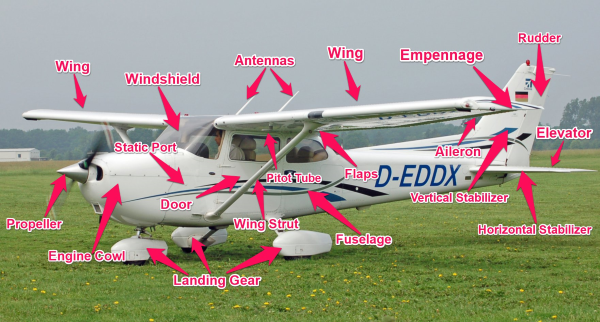Airplanes are able to conquer gravity, and therefore they have a certain mystique about them.
However, the principles of flight were figured out rather quickly, and the typical airplane looks similar to the way it did 100 years ago.
While technology has improved, many of the systems, such as the engines, are essentially the same designs as they were in the 1930’s.
The layout of an airplane has remained more or less the same since then, with only a few exceptions.
In general, the wings are attached to the upper or lower part of the fuselage, the rear of which is the empennage, containing the rudder and elevator.
As they say, the devil is in the details, and in this article we will explore all of the major systems of a typical airplane.
What are the main parts of an Airplane?
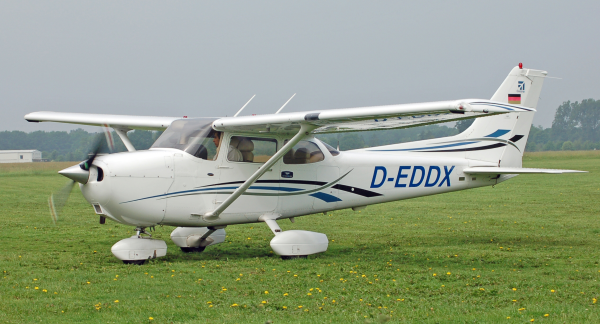
Airplanes are complex machines with unique technology, but you don’t need to be a rocket scientist to figure out how they are put together.
In this article, we will go over and explain all of the major parts of a typical General Aviation airplane, such as a Cessna 172.
- Fuselage
- Wings
- Wing Struts
- Ailerons
- Flaps
- Landing Gear
- Empennage
- Vertical Stabilizer
- Horizontal Stabilizer
- Rudder
- Elevator
- Trim Tabs
- Windshield
- Doors
- Propeller
- Engine Cowl
- Fuel Tanks
- Antennas
- Static Port
- Pitot Tube
- Stall Warning
As you can see, there are many systems that make up even a simple airplane. Sit tight and keep reading for everything you need to know about the parts of an aircraft!
Related Article – Airspace Classes Explained: The Ultimate Guide
What is the Fuselage?
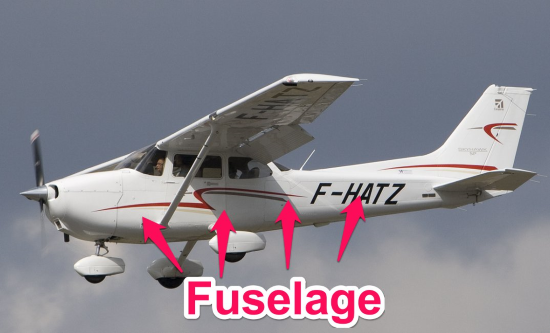
The fuselage is the main part of the aircraft, designed to accommodate crew, passengers and cargo. All of the other components are attached to the fuselage.
The most common fuselage structure design is called the monocoque, which is French for “single shell”, and is usually made from aluminum.
However, many newer aircraft use shells made of composite material. While weighing less, it is more difficult to manufacture, repair, and modify.
Some older designs used wood, steel, or aluminum tubing, and used fabric to cover the fuselage.
What are Wings?
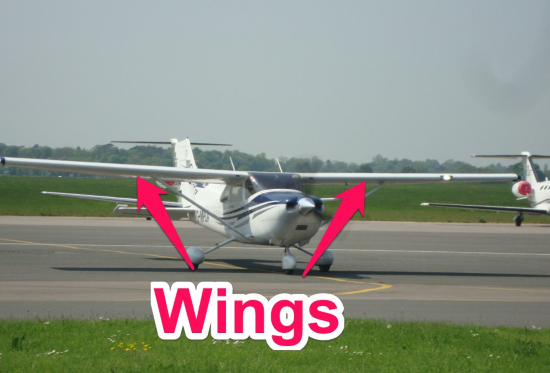
The wings are airfoils, the main lifting devices of an airplane, and can be attached to the top, the middle, or the bottom of the fuselage.
Most Cessnas, such as the 172, are known as high-wing aircraft, because of their placement at the top of the fuselage.
Most Pipers, such as the Cherokee, are low-wing aircraft because the wings are attached to the bottom of the fuselage.
The wings are typically made of a main structural member, the spar, located towards the front of the wing.
Numerous ribs are attached to the spar, and give the wing the shape of the airfoil and determine its lift characteristics.
Small strips of material, parallel to the spar, also connect to the ribs to ensure they maintain their shape, and are called stringers.
Thin aluminum skin is tightly attached to the ribs, enclosing the wing, and making it complete.
Rarely, planes have the wings mounted in the center of the fuselage, but this rare due to the wing spar intruding on the passenger space.
Planes with a single set of wings are referred to as monoplanes, and those with two sets of wings are known as biplanes.
Many other aircraft systems are attached to the wings, and will be discussed later.
What are the Wing Struts?
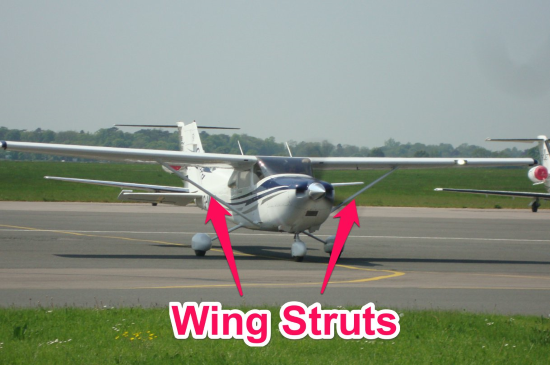
Many high-wing airplanes have braces, also known as Wing Struts, which transmit flight and landing forces from the wing to the fuselage.
Wing struts are typically attached to the middle of the wing, and again at the bottom of the fuselage, and this type of wing design is known as semi-cantilever.
Most low-wing planes, and a few high-wing designs, carry the fight forces without struts, and are known as full cantilever designs.
What are Ailerons?
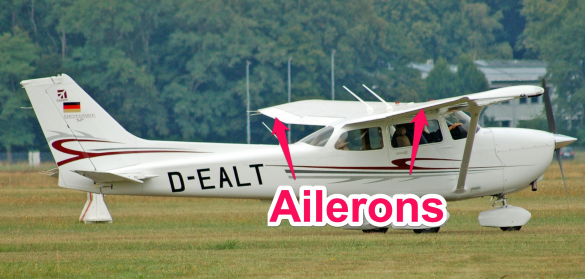
At the rear, or trailing edge, of the wing, from approximately the mid-point to the wing tip, are control surfaces called Ailerons.
Each aileron moves in the opposite direction from the other one, which create aerodynamic forces that cause the airplane to roll.
Turning the yoke from side to side, like a car steering wheel, controls the ailerons.
What are the Flaps?
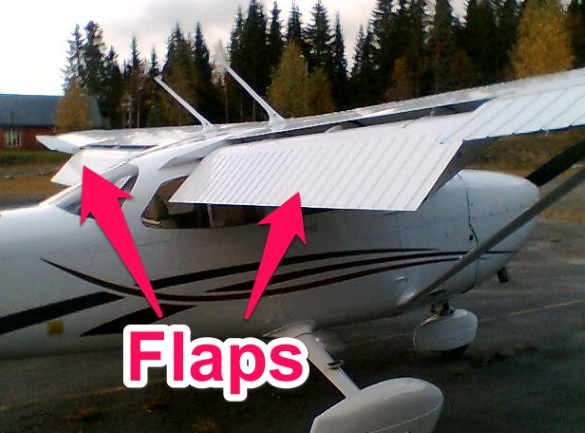
The flaps are also located at the trailing edge of the wing, but are located inboard, in between the aileron and the fuselage.
During cruise flight, the flaps are flush with the wings, but when deployed for landing, they move simultaneously downward, creating extra lift as well as drag.
This enables the plane to descend at a steeper angle for the same airspeed, requiring less runway for landing.
Related Article – How Do Fowler Flaps Work?
What is the Landing Gear?
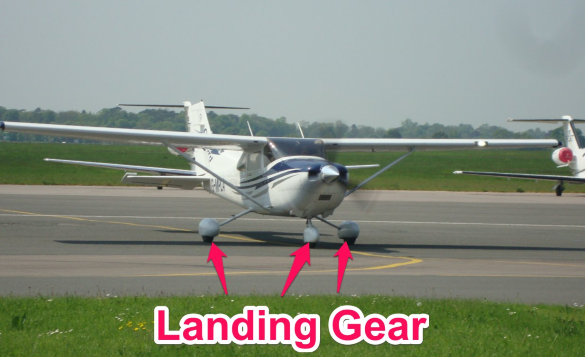
The landing gear houses the wheels, which supports the airplane while parked, taxiing, taking off, and landing.
Most general aviation airplanes have three wheels, two main wheels attached to the fuselage, and a third wheel attached to either the front or the rear of the fuselage.
If the third wheel is attached at the rear of the fuselage, this is known as tailwheel, and the configuration is called ‘conventional landing gear.’
With a conventional landing gear, the third wheel is attached to the rudder, and moves with the rudder inputs, controlling the steering while on the ground.
Most classic airplanes before the 1950’s used conventional land gear layouts.
If the third wheel is attached to the nose, it is known as a nosewheel, and the configuration is called ‘tricycle landing gear.’
The nose wheel is linked to the rudder pedals and controls ground steering.
The two main wheels in the fuselage also contain the brakes in both conventional and tricycle gear airplanes, and are individually controlled, called differential braking.
The brakes are normally used to stop, but because they are individually controlled, can also be used to assist in steering.
What is the Empennage?
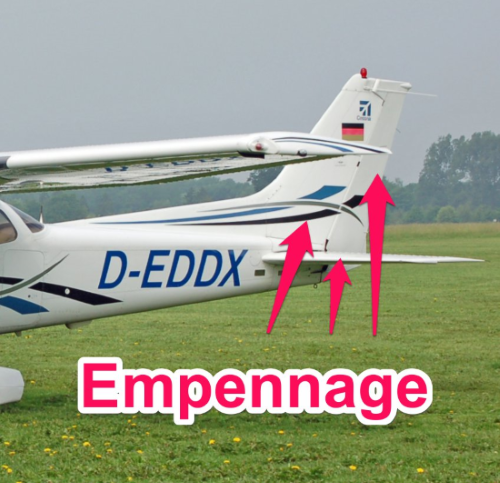
Located at the rear of the fuselage, the Empennage is the entire tail group, consisting of the Vertical Stabilizer, the Horizontal Stabilizer, the Rudder, the Elevator.
What is the Vertical Stabilizer?
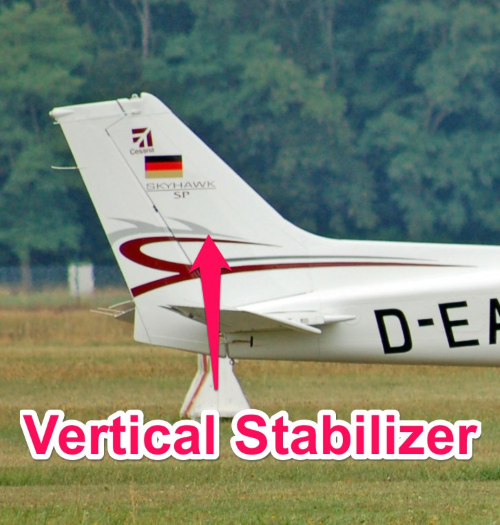
The Vertical Stabilizer is the tall, vertical part of the empennage, in which the rudder is attached.
At the very top of the Vertical Stabilizer, the rear position light, along with the beacon, are located.
What is the Horizontal Stabilizer?
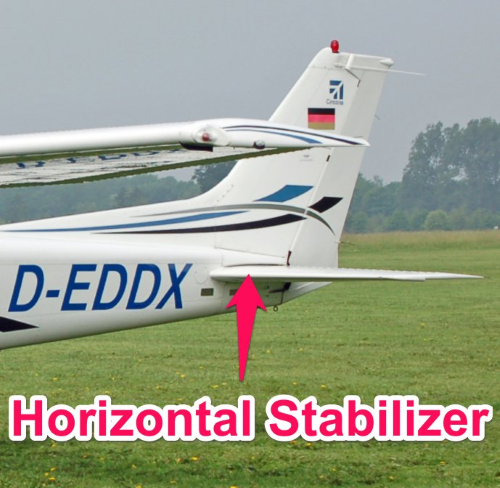
The Horizontal Stabilizer is the horizontal, or side to side, part of the empennage, in which the elevator is attached.
What is the Rudder?
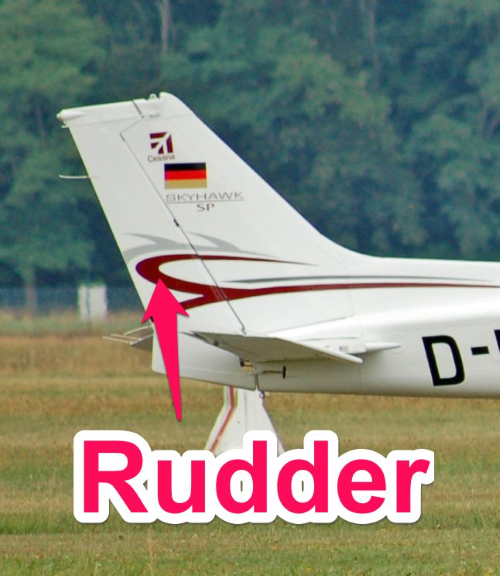
The rudder is the control surface at the rear of the vertical stabilizer which controls side to side movement, called yaw.
The rudder is controlled by two foot pedals in the cockpit, called rudder pedals.
The brake controls are normally incorporated into the rudder pedals, using hinged levers at the tops of the pedals.
What is the Elevator?
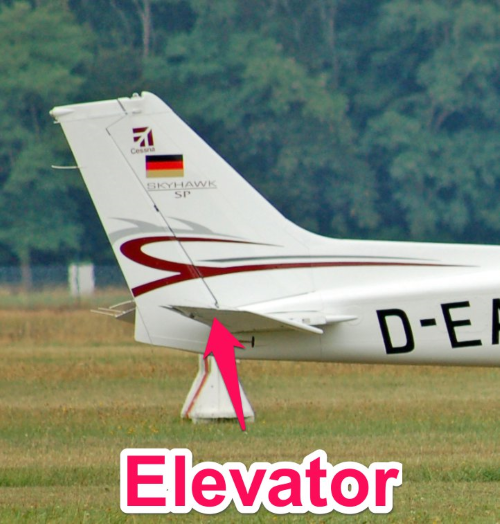
The elevator is attached to the rear of the horizontal stabilizer, and controls pitch, or up and down, movement.
It is controlled by forward and backward movement of the yoke. Pushing the yoke inward pitches the plane down, pulling the yoke towards you pitches the plane up.
Some empennage designs combine the elevator with the horizontal stabilizer.
In this design, the entire surface moves around a hinged point inside the vertical stabilizer. This layout is called a ‘stabilator.’
What are Trim Tabs?
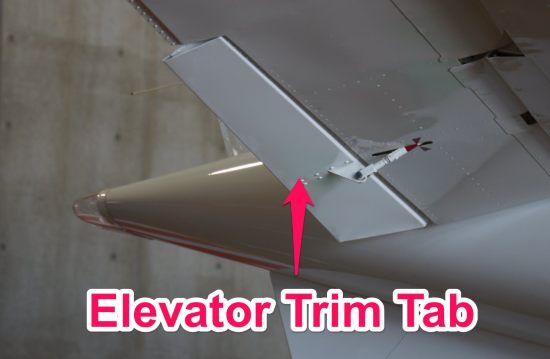
Trim Tabs are small, movable parts of the trailing edge of the control surface.
They may be installed on the rudder, the elevator, and/or the ailerons.
They are used to reduce control pressure on the yoke/pedals.
Related Article – Aircraft Altimeters Explained
What is a Windshield?
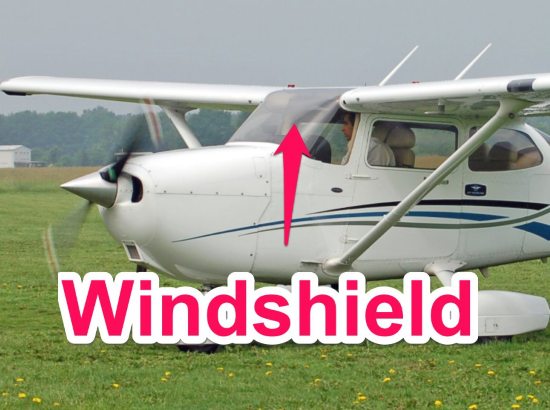
Getting blasted in the face by 100+mph wind is no fun for anyone, so aircraft designers decided to install windshields to protect the pilot and passengers.
They are typically a single piece of clear, molded plastic, and glued onto the front part of the fuselage.
Many windshields have provisions for the magnetic compass, keeping it close to eye level so it is easy to read, and sometimes an outside air temperature (OAT) gauge.
What are the Doors?
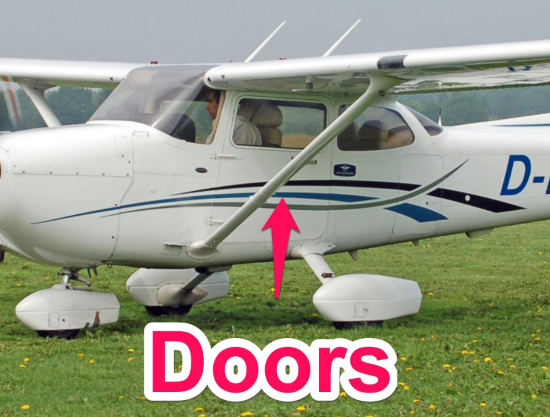
The doors are the primary way passengers and crew enter the plane, just like a car door.
Some planes have two doors, however, to save weight, some often only a single door.
Most have small flaps, or some other device, to allow outside air in, but usually only on the ground during taxi.
As most small airplanes don’t have air conditioning, the pilots/passengers need a way to keep cool while taxiing on a hot day.
The forces on the flaps/windows in flight normally are to great, and could cause damage if they are open while flying.
There are usually overhead vents used for cooling in flight, taking air from intakes in the wing roots.
The doors are latched inside, and can be locked for security, just like a car door.
What is a Propeller?
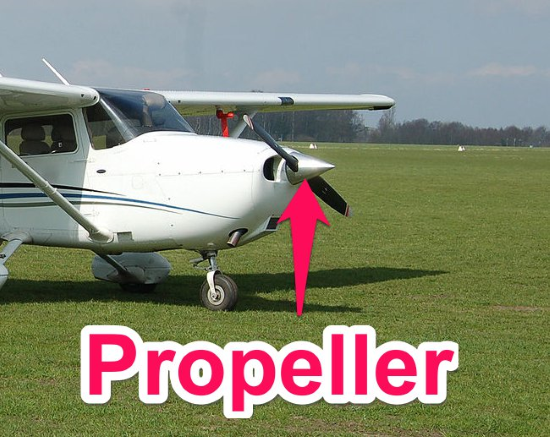
The Propeller is the thing in the front of the plane that keeps a pilot cool. If it stops moving, the pilot starts to sweat!
The propeller is attached to the engine at the front of the airplane, and is the primary method of transmitting engine power into the air to enable flight.
Consisting of two or more blades of specially designed airfoils, each turn of a propeller blade takes a certain bite of air, translating that into forward motion.
Most small planes have fixed propellers, which cannot be adjusted, but other propellers can vary the pitch, taking different amounts of “bites” of air.
This makes the plane more efficient and allows for the engine to be less stressed.
What is an Engine Cowl?
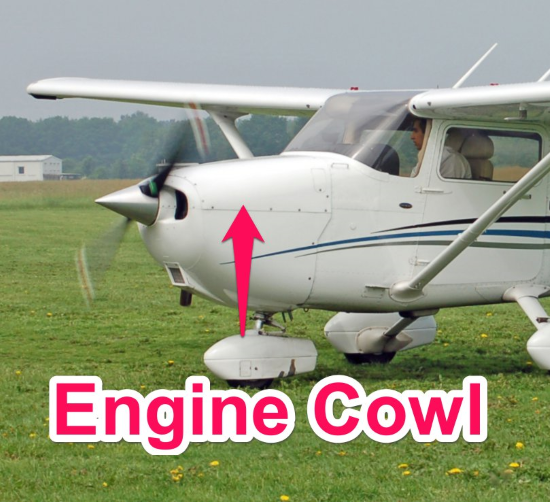
The Engine Cowl surrounds the engine and accessories in an aerodynamic shell, decreasing drag, and aiding in engine cooling.
Some engine cowls are hinged for easy maintenance access, while some offer only small access panels for checking oil, and must be totally removed for maintenance.
However, most cowls are attached to the fuselage using a handful of quarter turn screws, and therefore don’t take much time to remove.
What are the Fuel Tanks?
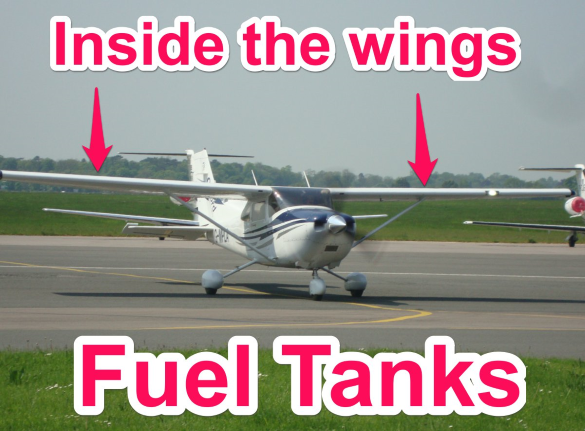
The fuel tanks are located in the inboard section of the wings, typically in front of the spar, or in-between the main spar and a rear spar.
There are normally two fuel tanks, one in each wing, and are located inboard due to the density and weight of the fuel.
Centripetal forces are less when the weight is inboard, keeping roll rate more consistent and requiring less control input.
On high-wing airplanes, the fuel tanks are located above the induction system, and can use gravity to feed the engine.
Low-wing airplanes need fuel pumps to feed the engine.
A valve, located in the cockpit, controls which tank is feeding the engine, the left tank, right tank, or both.
What are Antennas?
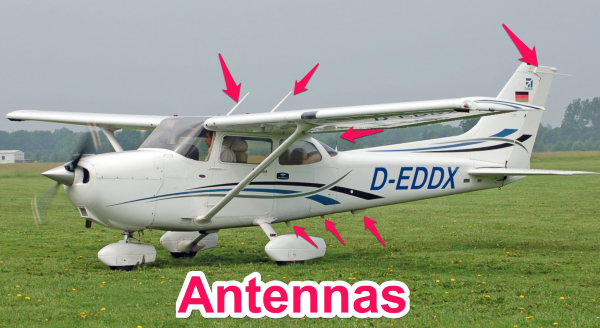
With all of the different types of radios and technology in modern airplanes, antennas are a necessity.
There are many different types of antennas, their designs based on their requirements.
For the radios, typically operating in VHF, monopole antennas, like old car antennas, are used to transmit and receive.
GPS antennas are small, teardrop shaped, and are located on top of the fuselage where they have access to satellite data.
Other types of antennas, such as for ILS systems, are sometimes located on the bottom of the fuselage.
Antennas come in many shapes and sizes, but all must be thin and/or aerodynamic to minimize drag.
What is a Static Port?
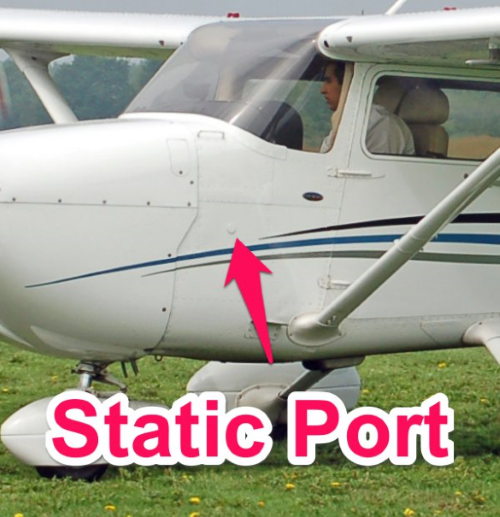
The Static Port is a small hole in the side of the fuselage that allows outside air pressure into the instruments that require it.
The airspeed indicator (ASI), vertical speed indicator (VSI) and the altimeter, all use the input from the static port.
If the static port becomes clogged, there is often a second static source located inside the cockpit.
While not as accurate because it is not reading full outside air, it allows the instruments to work again, and increases the margin of safety.
What is the Pitot Tube?
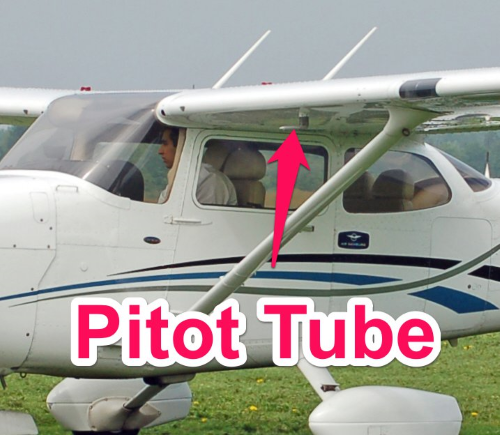
The pitot tube is a small hollow metal tube, usually located in the bottom of the left wing, facing into the airstream.
Fast moving air impacts a small hole on the front of the pitot tube, creating a ram air effect and increasing the pressure of the air inside the pitot tube.
This pressurized air is fed into the altimeter, and is compared with the static air taken from the static port.
The difference in the pressurized air and the static air is displayed on the ASI as the indicated airspeed.
What is the Stall Warning?
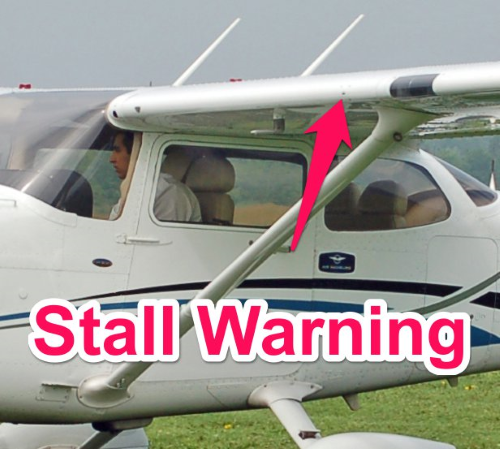
The Stall Warning system alerts pilots when they are within a few miles per hour of stall speed.
The simplest system uses a small hole in the wing, which is attached to a reed and a speaker baffle located in the cockpit.
At high angles of attack and low airspeeds, the low pressure around the hole in the wing creates suction.
That suction activates a small reed, like in a wind instrument, and amplifies the vibration of the reed through the speaker, resulting in an annoying buzz, like a high-pitched kazoo.
The simple reed stall warning system requires no electricity, although some manufacturers use a flap and switch design that does.
Both types of stall warning systems can and should be tested during a preflight. The reed system can be tested by covering the hole with cloth and inhaling.
Conclusion
And there you have it, the main parts of an aircraft explained!
While there is even more detail involved with airplanes, such as the avionics and greater details about the control system, this article should give you a good overview of the basic systems.
The main part of an aircraft is the fuselage, of which everything else is attached to.
The empennage is the rear portion of the fuselage, and contains the vertical stabilizer with rudder, and the horizontal stabilizer with elevator.
The wings are attached to the fuselage, usually in high-wing or low-wing configurations.
High-wing configurations normally have wing struts, which help transmit forces into the fuselage. Low-wing planes don’t have wing struts.
The wings also contain many things, such as the ailerons, which control roll, and flaps, which help increase the descent angle for landing.
Inside the wings are the fuel tanks, which hold the gas for the airplane, and are pumped into the induction system by either gravity, or with fuel pumps.
On the bottom of the fuselage are the wheels, with two main wheels under the fuselage and either a nose or a tail wheel.
The nose/tail wheel controls the airplane while on the ground, and the main wheels have the brakes, which can be used differentially to assist with steering.
At the front of the engine is the engine and propeller, essential pieces for powered flight.
All of these parts combine to create the wonderful, magnificent, fascinating airplane!
References
- https://upload.wikimedia.org/wikipedia/commons/2/29/Cessna_172_Skyhawk_%28D-EDDX%29_02.jpg
- https://upload.wikimedia.org/wikipedia/commons/a/ae/Cessna_172S_Skyhawk_SP%2C_Private_JP6817606.jpg
- https://upload.wikimedia.org/wikipedia/commons/8/8b/Cessna_172_Skyhawk_at_London_Oxford_Airport%2C_Oxfordshire%2C_UK_-_20120523.jpg
- https://upload.wikimedia.org/wikipedia/commons/3/39/Cessna_172_Skyhawk_(D-EALT)_02.jpg
- https://upload.wikimedia.org/wikipedia/commons/c/c5/FlapsLNAGT2.jpg
- https://upload.wikimedia.org/wikipedia/commons/b/b4/JMSDF_TC-90(6825)_elevator_trim_tab(right)_low-angle_view_at_Tokushima_Air_Base_September_30%2C_2017.jpg
- https://upload.wikimedia.org/wikipedia/commons/thumb/0/06/Cessna_172_Skyhawk_%28D-EDDX%29.jpg/1280px-Cessna_172_Skyhawk_%28D-EDDX%29.jpg

